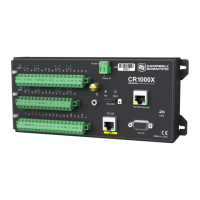Ratiometric differential measurement instructions allow both RevDiff and RevEx to be set
True. This results in four measurement sequences, which the datalogger processes into the
reported measurement:
l positive excitation polarity with positive differential input polarity
l negative excitation polarity with positive differential input polarity
l positive excitation polarity with negative differential input polarity
l negative excitation polarity with negative differential input polarity
For ratiometric single-ended measurements, such as a BrHalf(), setting RevEx = True
results in two measurements of opposite excitation polarity that are subtracted and divided by 2
for offset voltage reduction. For RevEx = False for ratiometric single-ended measurements,
an offset-voltage measurement is determined from self-calibration.
When the datalogger reverses differential inputs or excitation polarity, it delays the same settling
time after the reversal as it does before the first sub-measurement. So, there are two delays per
measurement when either RevDiff or RevEx is used. If both RevDiff and RevEx are True,
four sub-measurements are performed; positive and negative excitations with the inputs one way
and positive and negative excitations with the inputs reversed. The automatic procedure then is
as follows:
1. Switch to the measurement terminals.
2. Set the excitation, settle, and then measure.
3. Reverse the excitation, settle, and then measure.
4. Reverse the excitation, reverse the input terminals, settle, measure.
5. Reverse the excitation, settle, measure.
There are four delays per measurement. In cases of excitation reversal, excitation time for each
polarity is exactly the same to ensure that ionic sensors do not polarize with repetitive
measurements.
Read More: The Benefits of Input Reversal and Excitation Reversal for Voltage Measurements.
Measuring ground reference offset voltage
Single-ended and differential measurements without input reversal use an offset voltage
measurement with the PGIA inputs grounded. This offset voltage is subtracted from the
subsequent measurement. For differential measurements without input reversal, this offset
voltage measurement is performed as part of the routine background calibration of the
datalogger (see About background calibration (p. 100)). Single-ended measurement instructions
VoltSE() and TCSe() include the MeasOff parameter determines whether the offset
voltage measured is done at the beginning of the measurement instruction, or as part of self-
calibration. This option provides you with the opportunity to weigh measurement speed against
6. Measurements 60

